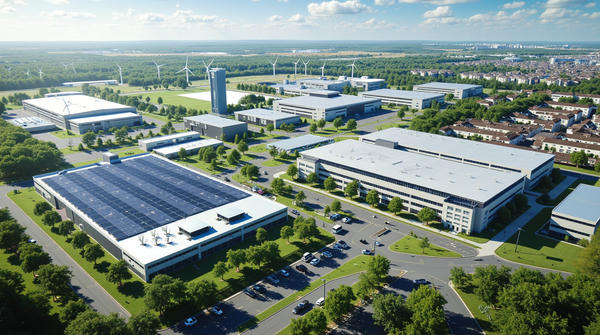Green Hydrogen: The Key to Seasonal Storage for our Renewable Energies?

Have you ever heard of green hydrogen? There's a lot of talk about this technology, but it also raises a lot of questions. Is it really the miracle solution for storing our renewable energies? Isn't it too expensive? And what about its impact on our water resources? As climate change forces us to rethink our energy system, let's explore together the promises and challenges of this technology that could transform our future. 💧
What is Green Hydrogen?
Green hydrogen is produced by electrolysis of water using electricity from renewable sources, such as wind and solar power. Unlike other forms of hydrogen, which are generally derived from fossil fuels, green hydrogen is completely free of carbon emissions, making it an attractive option for reducing our overall carbon footprint.
The challenge of interseasonal storage
One of the greatest challenges posed by renewable energies is their intermittency. Solar panels only produce electricity when the sun is shining, and wind turbines only work when the wind is blowing. This means that there are periods of overproduction and others of deficit. Green hydrogen offers a potential solution to this problem by acting as a flexible energy carrier. It can store excess energy produced during periods of high production and release it when demand increases, even months later.
A documentary on current hydrogen research
Concrete examples of use
The HyDeploy Project in the UK
The HyDeploy project in the UK demonstrates an innovative approach by blending up to 20% green hydrogen into the existing natural gas network. This pilot project, carried out at Keele University, proved that it was possible to significantly reduce CO2 emissions without modifying infrastructure or consumer appliances.
Hydrogen Valley in France
In France, Normandie Hydrogène is a leading example of an integrated territorial ecosystem. This project brings together manufacturers, transporters and local authorities around a common vision. It includes the production of green hydrogen from offshore wind turbines, its use in local industry and the development of a fleet of hydrogen-powered buses.
The H2Med Corridor in Spain
Spain is developing the H2Med project, a green hydrogen corridor linking the Iberian Peninsula to France. This ambitious project aims to transform Spain into a major hub for green hydrogen production, exploiting its significant solar and wind energy potential. The project aims to produce over 2 million tonnes of green hydrogen per year by 2030.
The German WindGas model
In Germany, the WindGas project demonstrates the efficiency of underground hydrogen storage. Using surplus wind power from the north of the country, this project produces green hydrogen, which is then stored in old salt caverns. This approach not only stabilizes the electricity grid, but also ensures energy supplies during periods of high winter demand.
Challenges to overcome
Although green hydrogen offers many advantages, it faces significant challenges. The cost of production remains high compared with other forms of energy, and there are also logistical obstacles associated with transporting and storing hydrogen. However, with continued investment in research and development, these obstacles can gradually be overcome.
Economic and environmental issues
Production Costs: An Encouraging Drop
The cost of producing green hydrogen has long been considered a major obstacle to its development. In 2020, it was between €4 and €6/kg. However, technological advances and economies of scale are bringing costs down steadily. Analysts predict a cost of €2/kg by 2030, making green hydrogen competitive with grey hydrogen (derived from fossil fuels).
Several factors contribute to this cost reduction:
- The falling cost of renewable energies (solar power has been divided by 10 in 10 years)
- Improved electrolyzer efficiency (from 65% to over 80%)
- Industrialization of production (40% reduction in manufacturing costs)
The Issue of Water: A Controlled Impact
Producing 1 kg of hydrogen requires around 9 liters of pure water. This consumption raises legitimate questions about environmental impact. However, several solutions are emerging:
- The use of desalinated seawater (technology already operational in Portugal)
- Recovery of water produced by fuel cells (quasi-closed circuit system)
- Process optimization reducing water consumption by 20%.
To put these figures into perspective, producing green hydrogen to fuel a car for a year (around 150 kg of H2) requires less water than a hectare of corn over the same period.
Promising prospects
Current projects show that these challenges are not insurmountable. For example, the GRHYD project in France has shown that, with large-scale production, the cost of green hydrogen could already fall below €3/kg. What's more, technological innovations such as membrane electrolyzers mean that 35% less water can be used than five years ago.
Real-life application: energy self-sufficiency for a small business
Let's take the example of a 500m² SME looking to become energy self-sufficient. With an average annual consumption of 50,000 kWh, this company faces a particular challenge: its winter consumption (30,000 kWh) is significantly higher than its summer consumption (20,000 kWh). 🏢
Solar and Hydrogen Storage System
To achieve self-sufficiency, the company installs a 60 kWp photovoltaic power plant that produces around 60,000 kWh per year. During the summer, the excess production (around 20,000 kWh) can be converted into green hydrogen via a 30 kW electrolyzer. With a conversion efficiency of around 75%, this produces around 450 kg of hydrogen.
Seasonal Energy Balance
- Summer: Solar production of 40,000 kWh
- Direct consumption: 20,000 kWh
- Surplus converted into H₂: 20,000 kWh → 450 kg of H₂
- Winter: Solar production of 20,000 kWh
- Total consumption: 30,000 kWh
- Shortfall made up by stored H₂: 10,000 kWh
Economic aspects
The initial investment for such a system (solar panels, electrolyzer, H₂ storage and fuel cell) is around €200,000. With a lifespan of 20 years and savings on the energy bill (around €15,000 per year), the return on investment is estimated at 13-15 years. These figures improve every year as technology costs fall and energy prices rise. 💰
Additional benefits
Beyond energy autonomy, this system offers security of supply and long-term energy cost stability. It also enables the company to reduce its carbon footprint by around 10 tonnes of CO₂ per year, an argument increasingly valued by customers and partners.
Conclusion
Green hydrogen has the potential to revolutionize our approach to energy storage and distribution, particularly in the transition to renewable energy sources. By overcoming current challenges, we can hope to see this technology play a central role in our sustainable energy future. 🌱🔋
Ultimately, green hydrogen could well be the key to unlocking the full potential of renewable energies, enabling us to move towards a cleaner, more sustainable future. If we are to achieve our ambitious climate goals, it's time to take this technology seriously and integrate it into our overall energy strategy.




